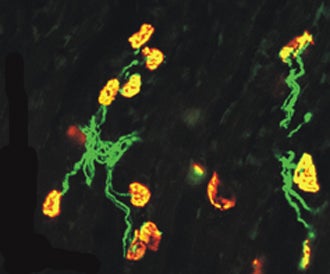The basic principles governing communication between the cells of our nervous system are determined by their molecular constituents. Neuroscientists at USC investigate the mechanisms that shape neural signaling by studying how molecules work together in space and time to regulate the functional properties of neurons. These cellular components include a neuronal-specific complement of cell-surface receptors, ion channels, transporters, transmitters, and signaling proteins. The mechanisms by which these specific molecules regulate a diverse array of processes are being actively investigated, including: modes of excitability in axons versus dendrites; synaptogenesis and synaptic communication and plasticity; the ability of axons to project to their targets; and sensory processing and signal transduction. USC scientists accomplish their research goals using a wide range of methods to identify and manipulate the molecular components of cells. These approaches include the use of microarrays to screen for genes of interest, cellular imaging and electrophysiological recordings to determine functional properties of neuronal proteins, and the generation and testing of transgenic animals.

One specific area of focus is on sensory systems, where USC researchers have made major contributions to our understanding of the signaling pathways that underlie vision, taste, pheromones, and somatosensation. Another area in which USC researchers continue to make important scientific contributions is in the mechanisms of trafficking and regulation of ion channels, receptors, and transporters. Because these proteins determine the electrical excitability of both peripheral and central neurons, understanding these processes has implications for the treatment of psychiatric, neuromuscular, and degenerative disorders of the nervous system. The study of synaptic communication and regulated secretion are other areas of strength at USC. Researchers have made key discoveries in the ways in which synaptic transmission is altered during learning, aging, and in response to hormones or drugs of abuse, as well as in the fundamental mechanisms of secretion. Finally, an important area of research in cell-molecular neuroscience at USC is focused on identifying genes that comprise the molecular basis for complex behaviors, such as courtship in the fly and ingestive and sensory behaviors in mammals.
Robust interactions among USC neuroscientists working at the cellular and molecular level are enhanced by weekly journal clubs and technical support is provided by a number of core facilities, including a transgenic mouse core. Molecular neuroscientists further benefit from collaborations with colleagues in computational and molecular biology, who excel at analyzing large and complex data sets.